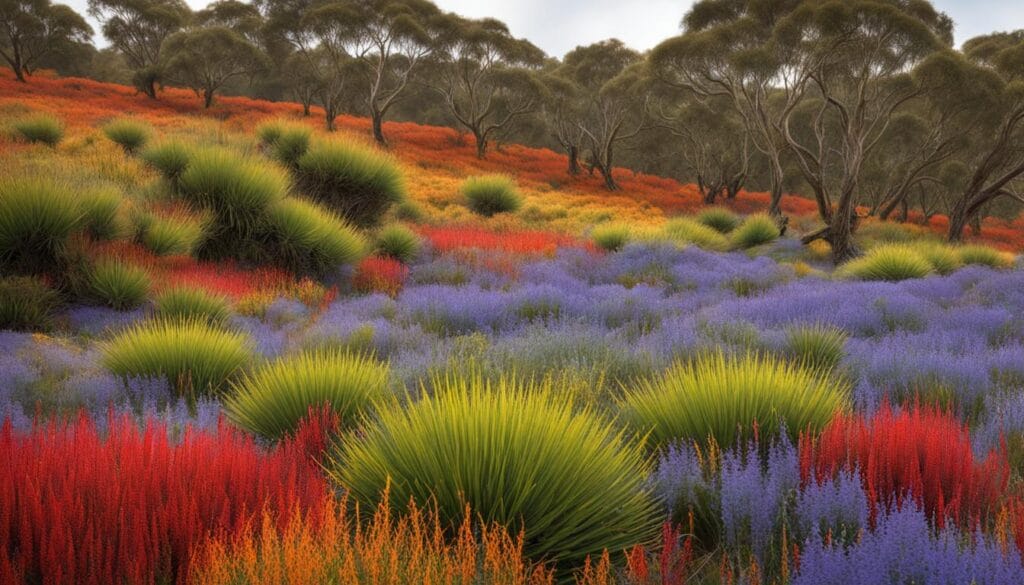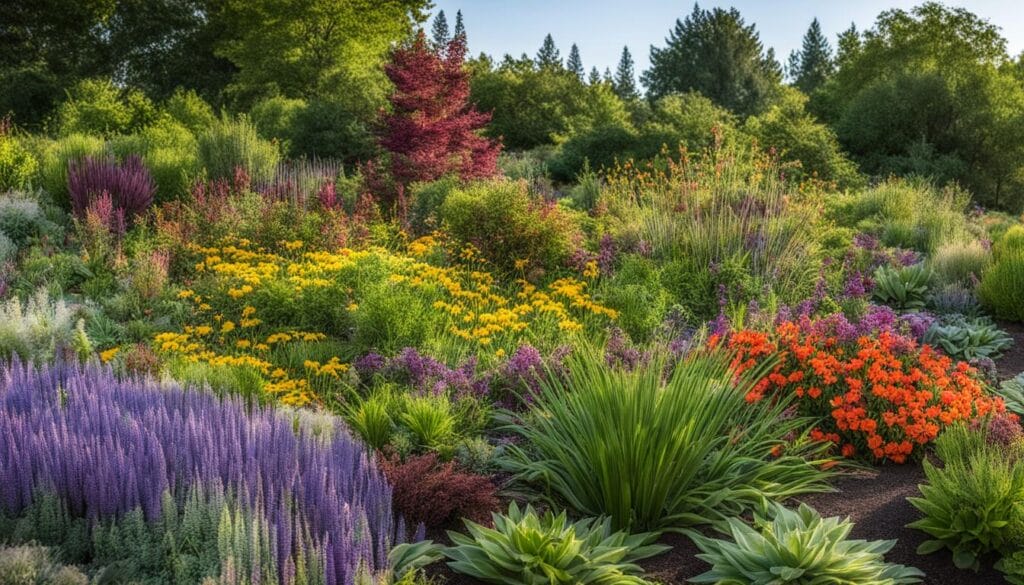Welcome to an exploration of the incredible impact that native plants have on local ecosystems in Australia. As urbanization continues to encroach upon natural habitats, it is more important than ever to understand the benefits of using native plants for biodiversity and ecosystem preservation. By incorporating these plants into your landscaping, you can support thriving ecosystems and provide vital resources for local wildlife.
Native plants play a vital role in maintaining the balance of Australian ecosystems. Let’s delve into the ecological significance of these plants and discover how they contribute to habitat restoration and conservation efforts. We will also explore the threats that native plants face and the conservation measures we can take to protect and restore their populations.
Key Takeaways:
- Native plants are essential for supporting functioning ecosystems and promoting biodiversity.
- By choosing native plants for landscaping, you can provide habitat, shelter, and food for local wildlife.
- Native plants offer low maintenance, beauty, and environmental benefits, including water conservation and soil strength.
- Invasive plant species and land development pose threats to native plant populations.
- Conservation efforts, such as rewilding yards and advocating for protection, are crucial for native plant restoration.
The Ecological Significance of Native Plants
Native plants have a vital role to play in maintaining the health and balance of ecosystems. Their importance extends far beyond their aesthetic appeal. By choosing native plants for landscaping and conservation efforts, you can contribute to the restoration and preservation of these valuable species.
One of the key reasons why native plants are so ecologically significant is their ability to support local wildlife. These plants have coevolved with insects, birds, and other animals, creating mutually beneficial relationships. Native plants provide essential food sources and habitats for these species, ensuring their survival and contributing to the overall biodiversity of the ecosystem.
Moreover, native plants offer numerous benefits to both the environment and human well-being. They require less maintenance, fertilizer, and water compared to non-native species, making them a sustainable and eco-friendly choice for landscaping. Native plants also strengthen soil, prevent erosion, and combat climate change by sequestering carbon dioxide. Additionally, their beauty, seasonal changes, and the variety of flowers they produce create visually engaging landscapes that enhance the aesthetics of any space.
“Native plants are the ecological basis upon which life depends. They support not only birds and insects but also other forms of wildlife. Landscaping choices have a significant impact on bird and insect populations.”
The Importance of Native Plants in Ecosystems
Native plants are crucial for maintaining the balance and health of ecosystems. They form the foundation of the food web, providing sustenance for a wide range of organisms. Insects, in particular, rely on native plants for food during their larval stage, and birds depend on these insects for survival. Without native plants, the entire ecosystem would suffer, leading to population declines and disruptions in the natural cycle of life.
Furthermore, native plants have adapted to the local environment over time, making them better suited to withstand climate conditions and requiring less intervention. Their deep root systems help retain water, reducing the need for irrigation. Native plants also act as natural filters, improving water quality by reducing runoff and filtering pollutants. By promoting the growth and preservation of native plants, we can ensure the long-term health and resilience of our ecosystems.
| BENEFITS OF NATIVE PLANTS | IMPORTANCE FOR ECOSYSTEMS |
|---|---|
| Low maintenance | Support biodiversity |
| Strengthen soil | Prevent erosion |
| Combat climate change | Provide habitat and food sources for wildlife |
| Conserve water | Improve water quality |
By recognizing the ecological significance of native plants and actively promoting their conservation and restoration, we can create healthier and more sustainable environments for both wildlife and ourselves.
Native Plants in Australia
Native plants in Australia play a vital role in promoting biodiversity and habitat restoration. These plants are species that have evolved and adapted to the local conditions and climate over many years, making them uniquely suited to thrive in their specific regions. By planting native plant species, individuals can contribute to the preservation of Australia’s rich natural heritage while enjoying the numerous benefits these plants offer.
The Importance of Native Plants
Native plants in Australia provide multiple advantages for gardens and natural landscapes. One of their key benefits is the ability to survive on rainfall alone, reducing the need for additional watering. This not only saves water but also promotes sustainable gardening practices. Native plants also serve as habitat, shelter, and food sources for local wildlife, creating a thriving ecosystem that supports the health and well-being of various species.
“Native plants are essential for maintaining the delicate balance of Australia’s ecosystems. They attract pollinators like bees and butterflies, which are crucial for the reproduction of many plant species. Additionally, native plants provide nectar, fruits, and seeds that sustain a wide range of birds, insects, and small mammals.”
Promoting Native Plant Populations
Conservation efforts are vital for preserving and promoting native plant populations in Australia. Protecting and restoring native vegetation not only enhances biodiversity but also helps combat the threats posed by invasive plant species and land development. By incorporating native plants into gardens, parks, and urban landscapes, individuals can contribute to the conservation of Australia’s unique plant species and create healthier, more sustainable environments.
| Benefits of Native Plants in Australia | Promoting Native Plants |
|---|---|
| 1. Conservation of Australia’s rich biodiversity | 1. Incorporating native plants into gardens and landscapes |
| 2. Reduction in the need for additional watering | 2. Supporting local nurseries and organizations that specialize in native plants |
| 3. Creation of habitat and food sources for local wildlife | 3. Participating in community-driven restoration projects |
| 4. Preservation of Australia’s unique natural heritage | 4. Advocating for greater protection of native plant species |
The Importance of Native Plants in Ecosystems
Native plants play a critical role in maintaining the balance and diversity of ecosystems. These plants have coevolved with local wildlife over time, creating mutually beneficial relationships that are essential for the survival of both plants and animals. By promoting native plant populations, we can help preserve biodiversity and support the overall health of our ecosystems.
One of the key benefits of native plants is their ability to attract a wide range of insects, birds, and other animals for pollination and reproduction. These interactions are crucial for the survival of many species, as native plants provide the necessary food and habitat for small organisms that form the base of the food chain. Without native plants, these small organisms would suffer, leading to population declines for larger animals down the line.
Native plants have adapted to their specific regions over time, making them resilient and requiring less maintenance, fertilizer, and water compared to non-native species. They also strengthen the soil, prevent erosion, and provide essential shelter for native animals.
Furthermore, native plants play a vital role in habitat restoration efforts. By planting native species, we can help restore damaged ecosystems and create healthy environments for local wildlife. Native plants act as a natural defense against invasive species, as they are better adapted to the local conditions and can outcompete non-native plants for resources.
Promoting Native Plant Populations
To promote native plant populations, it is important to prioritize their conservation and incorporate them into our landscaping and restoration projects. By choosing native plants for our gardens and green spaces, we can create thriving habitats for local wildlife and help support the overall health of our ecosystems. Additionally, advocating for the protection and restoration of native plant populations at the federal level can ensure their long-term survival.
| Benefits of Native Plants in Ecosystems | Promoting Native Plant Populations | Role of Native Plants in Habitat Restoration |
|---|---|---|
| Support biodiversity and ecological balance | Choose native plants for landscaping projects | Restore damaged ecosystems with native species |
| Provide essential habitat and food sources for wildlife | Advocate for federal protection of native plants | Create healthy environments for local wildlife |
| Require less maintenance, fertilizer, and water | Act as a natural defense against invasive species |
By recognizing the importance of native plants in ecosystems and taking action to promote their populations, we can contribute to the preservation of biodiversity and the overall health of our environment. Let’s embrace the beauty and value of native plants and make a positive impact on our local ecosystems.
Threats to Native Plants and Conservation Efforts
Conserving native plants is crucial for maintaining the balance of ecosystems and preserving biodiversity. However, these plants face significant threats from invasive species and land development. Invasive plants, introduced by human activities, compete with native plants for resources and disrupt the delicate ecosystem balance. They can outcompete native plants, hoard nutrients and water, and crowd out the native species.
Land development also poses a threat to native plants. As natural areas are replaced with concrete structures and uniform grass lawns, the native vegetation loses its habitat and is gradually lost. The loss of native plants not only affects the plants themselves but also has a cascading effect on the entire ecosystem, impacting the wildlife that relies on them for food, shelter, and reproduction.
Invasive Plant Species
The invasion of exotic plant species threatens the survival of native plants. Invasive plants have aggressive growth and reproductive strategies that allow them to quickly spread and dominate the landscape. They outcompete native plants for sunlight, nutrients, and water, resulting in the decline of native plant populations. This loss of native plants can have far-reaching consequences, as it disrupts the intricate web of ecological interactions and reduces biodiversity.
Land Development
As urbanization and land development continue to expand, natural habitats are being converted into residential and commercial areas. This conversion results in the destruction and fragmentation of native plant communities. The loss of native vegetation not only reduces the aesthetic value of the landscape but also leads to a decline in ecosystem services such as water purification, soil retention, and carbon sequestration.
| Threats to Native Plants | Conservation Efforts |
|---|---|
| Invasive plant species | Advocating for stricter regulations on the import and sale of invasive plants. |
| Land development | Encouraging the preservation of natural areas and promoting sustainable land-use practices. |
| Supporting habitat restoration projects focused on reintroducing native plants. |
To address these threats, it is crucial to raise awareness about the importance of conserving native plants. Advocating for stricter regulations on the import and sale of invasive plants can help prevent their introduction and spread. Additionally, promoting sustainable land-use practices and supporting habitat restoration projects focused on reintroducing native plants can help mitigate the impact of land development and restore native plant populations.
By taking small actions such as planting native species in our gardens and supporting conservation efforts, we can contribute to the protection and restoration of native plants and their associated ecosystems. Together, we can ensure a sustainable future for our natural environment.
Conclusion
Native plants in Australia are not only beautiful additions to your garden but also play a crucial role in supporting local ecosystems and promoting biodiversity. By choosing native plants for your landscaping and conservation efforts, you can have a positive impact on your local environment.
One of the key benefits of using native plants is their ability to provide habitat, shelter, and food for wildlife. By incorporating native plants into your garden, you create a welcoming space for birds, insects, and other animals, fostering a healthy ecosystem. Additionally, native plants contribute to a healthy environment by conserving water, reducing the need for artificial fertilizers and chemical pesticides.
Furthermore, native plants have the power to combat climate change. With their ability to sequester carbon and contribute to a more sustainable future, they play an important role in mitigating the effects of global warming. By restoring native plant populations, we can enhance the resilience of our ecosystems and protect the planet for future generations.
In conclusion, choosing native plants for your garden is a simple yet impactful way to support local ecosystems, promote biodiversity, and contribute to the restoration of native plant populations. By making this small change, you can make a big difference in the overall health and sustainability of our environment. So, why not start incorporating native plants into your garden today?
FAQ
What are the benefits of using native plants for landscaping?
Native plants provide habitat, shelter, and food for wildlife, contribute to a healthy environment, and help combat climate change.
How do native plants promote biodiversity?
Native plants support functioning ecosystems by providing essential habitat and food sources for birds, insects, and other wildlife.
Why are native plants important for local ecosystems?
Native plants have coevolved with local wildlife, creating mutually beneficial relationships that support ecosystem balance and preserve biodiversity.
What are some threats to native plants?
Invasive plant species introduced by humans can disrupt ecosystem balance by competing for resources and crowding out native plants.
What can individuals do to protect native plants?
By planting native species in gardens and advocating for greater federal protection, individuals can help protect and restore native plant populations.



